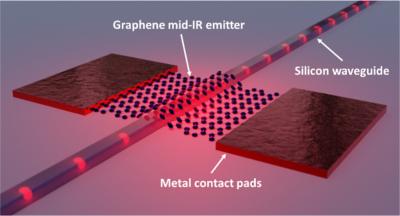Researchers at AMO GmbH, KTH Royal Institute of Technology, Senseair AB and the University of Bundeswehr have developed a waveguide-integrated incandescent thermal mid-infrared emitter using graphene as the active material. This innovative approach is said to significantly enhance the efficiency, compactness, and reliability of gas sensor systems, paving the way for widespread applications across various industries.
Many applications require robust, real-time air quality monitoring solutions, driving the demand for distributed, networked, and compact gas sensors. Traditional gas sensing methods, including catalytic beads and semiconducting metal oxide sensors, suffer from performance degradation, frequent calibration needs, and limited sensor lifetimes due to their reliance on chemical reactions. Absorption spectroscopy offers a promising alternative by utilizing the fundamental absorption lines of several gases in the mid infrared (mid-IR) region, including greenhouse gases. This method provides high specificity, minimal drift, and long-term stability without chemically altering the sensor. The ability to “fingerprint” gases through characteristic absorption wavelengths, such as carbon dioxide (CO2) at 4.2 μm, makes it a promising technology for precise gas detection.





